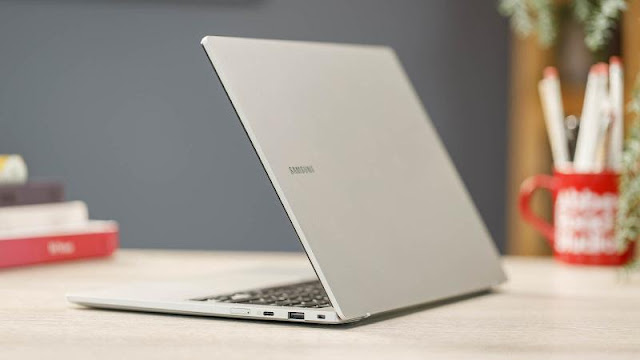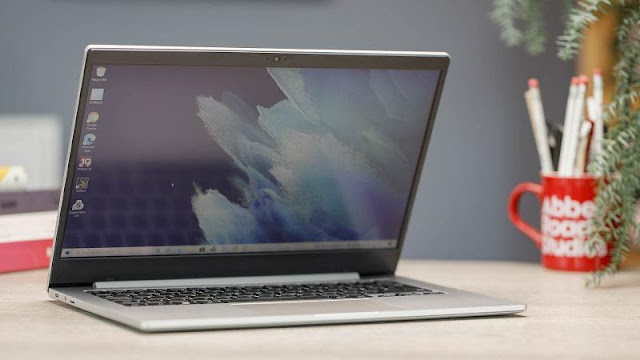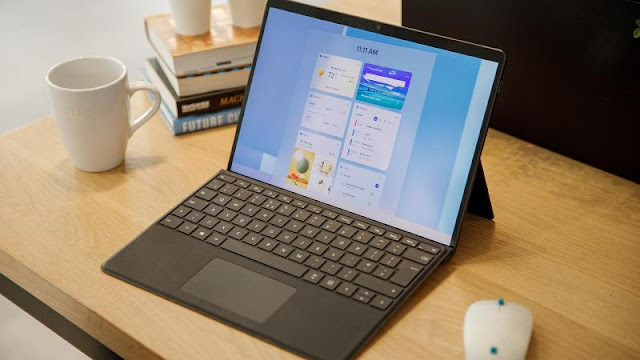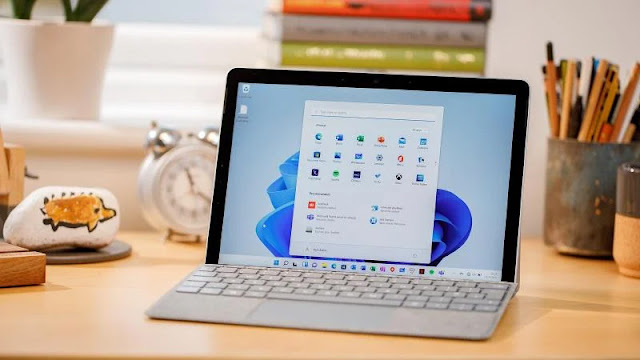The Samsung Galaxy Book Go sounds good on paper, but lots of ports and 4G connectivity can't make up for a dim screen and dismal performance.
Should I Buy The Samsung Galaxy Book Go?
Pros
- Great port selection & 4G
- Simple, slim design
- Good battery life
Cons
- Unbearably under-powered
- Dim, basic display
- Super-slow charging
Our Verdict
- The Samsung Galaxy Book Go has an attractive enough design, plenty of ports, and perks like excellent battery life and 4G connectivity, but its performance problems overshadow them all.
Price When Reviewed
- $349
The Galaxy Book Go is a lightweight, affordable laptop from Samsung that’s powered by a Qualcomm chip – instead of Intel – and offers the option of 4G connectivity.
On paper that sounds great, but in practice this laptop is abominably slow, with Windows still refusing to play nicely with Qualcomm’s Arm architecture. The result is a laptop that’s difficult to recommend, and undeniably outclassed by most Chromebooks at the same price.
Design And Build
- Slim and lightweight build
- Made of plastic
- Only available in silver
While I have my complaints about the Galaxy Book Go’s performance, I can’t really fault the way it looks.
It’s partly that light because the body is plastic, which is pretty inevitable at this price. That does make the laptop feel a bit cheap – but hey, it is cheap. So you can’t really complain too much about that.
Display And Audio
- 14in HD display
- Quite dim
- No touchscreen
The 14in display here is large for a laptop of this price, but it comes with drawbacks.
It’s Full HD, at 1920 x 1080, so at least Samsung hasn’t taken any shortcuts there as we’ve sometimes seen in other budget laptops.
Unfortunately, it’s not a great screen in other respects. Using a SpyderX to assess the screen’s performance, I found it capped at a max brightness of only 225 nits – about half of what the best laptop’s manage, though admittedly better than a few other cheap options.
It’s also a shame that there’s no touchscreen option. That’s not totally unusual for the price, but it would have helped make up for some of the laptop’s other shortcomings.
There are stereo speakers built into the laptop, but as you’d expect they’re pretty weak and tinny. They’ll do the job if you’re on a video call or want to watch something on YouTube, but for music or even Netflix viewing, you’ll definitely want to connect your headphones.
Keyboard And Trackpad
- Spacious keyboard
- Slightly mushy feel to typing
- Large plastic trackpad
There’s little to say about the keyboard and trackpad here, which are both par for the course for a budget computer.
The keyboard is pretty big, stretching most of the way to the sides of the device, though it’s a shame that Samsung has mostly achieved that by spacing the keys out rather than making the individual keycaps larger.
In typing the keyboard feels a little soft and mushy, not helped by fairly short key travel, but it’s responsive enough and gets the job done.
The trackpad is also typical. It’s large, which is welcome, but understandably made out of plastic. That makes it feel a little sluggish and adds a little friction as you drag your finger across, but you won’t find any better without spending much more.
Specs And Performance
- Powered by Qualcomm Snapdragon 7c Gen 2
- Almost unusably slow
- 4/8GB RAM & 128GB storage
And here’s the rub. So far the Galaxy Book Go probably seems fine – a little rough around the edges, but that’s what you get for a laptop that costs less than £500/$500.
The problem is all in the performance. This is one of a burgeoning range of Windows on Snapdragon laptops – devices powered by Qualcomm chips instead of Intel or AMD.
The Galaxy Book Go is powered by the Snapdragon 7c Gen 2, the latest version of Qualcomm’s less powerful tier of laptop chip. I’ve found it sluggish almost beyond the point of being useable, with basic tasks and simple apps hanging and freezing. Even running a single Chrome tab proved too much for this laptop at times.
If anything, the laptop's benchmark results flatter it. They show similar performance to the Acer Swift 1 and Lenovo IdeaPad 3i, but in our testing we found that both those laptops, while basic, handled day-to-day web browsing and email without a hitch. I can't say the same for the Galaxy Book Go.
When reviewing a laptop I normally make it my main device for the week, but I have to admit that I couldn’t bring myself to use the Galaxy Book Go much, either for work or browsing the web in the evenings.
It’s probably worth flagging that my review model runs with just 4GB of RAM. This is the only option in the US, though the UK and some other markets also get an 8GB RAM variant. Perhaps this will have superior performance – though with a £100 surcharge for the extra RAM (with no other spec changes) I personally wouldn’t pay the premium to find out.
The problem is that Windows is a complex operating system, and it simply can’t run well on such low-powered chips. At this price you’d be much better off looking at a cheap Intel chip if you really need Windows, or turning to a Chromebook. Samsung’s own Galaxy Chromebook Go is about the same price and comes with a less powerful chip than this, but because it runs the lightweight ChromeOS it offers much smoother performance.
Battery And Charging
- Excellent battery life
- Sluggish charging
For all its faults, Qualcomm’s 7c Gen 2 does bring one major strength: battery life.
In our testing the Galaxy Book Go lasted over 15 hours of continuous video playback – not the highest score we’ve ever recorded, but substantially better than most other budget rivals.
It’s a similar story in regular use, where you really won’t need to charge this laptop more than once every few days.
Connectivity
- Impressive range of ports
- 4G LTE
Connectivity is another key strength. For one, despite the slim build Samsung has baked in a surprising array of ports. There’s a USB-C port on each side for charging and data (one of which handles video output too), one USB-A 2.0 port, a 3.5mm headphone jack, a microSD card slot, and even a Kensington Nano lock slot.
Just as importantly, there’s a SIM card tray, because like all Qualcomm laptops this supports 4G LTE. You’ll need an extra SIM card – you can’t piggyback on your phone’s data plan, disappointingly – but if you don’t mind the ongoing outlay it’s incredibly convenient to get access to data even when there’s no good Wi-Fi around.
There’s also Wi-Fi of course (though not the latest Wi-Fi 6 or 6E standards) and Bluetooth 5.1 to connect up headphones or other accessories.
Price And Availability
The Galaxy Book Go is widely available, and starts from £399/$349/€499. You can buy it directly from Samsung, or from Amazon and other retailers.
It’s probably a much more appealing option in the US, where that price is cheap enough to perhaps make you overlook the performance problems – though I’d still hesitate.
Verdict
The Samsung Galaxy Book Go may benefit from an attractive enough design, plenty of ports, and perks like excellent battery life and 4G connectivity, but its performance problems overshadow them all.
All the ports in the world don’t matter when a laptop is this slow and frustrating for basic, everyday tasks, and even at a relatively affordable price this is really a false economy.
You’re much better off spending a little bit more for better performance elsewhere – or turning to a Chromebook for a budget laptop you won’t want to throw in the bin.
Specs
- Qualcomm Snapdragon 7c Gen 2
- 14in FHD LED Display (1920 x 1080), Anti-Glare
- 4GB LPDDR4x Memory
- 128GB storage
- Stereo Speakers ( 1.5 W x 2 )
- Internal Digital Mic
- 720p HD Camera
- Bluetooth 5.1, Wi-Fi 5
- 4G LTE
- 2x USB Type-C
- 1x USB 2.0
- MicroSD Multi-media Card Reader
- 1 Headphone out/Mic-in Combo
- Nano Security Slot
- 42.3Wh battery
- 25W USB-C charger included
- 324 x 225 x 15mm
- 1.38kg (3.04lbs)
- Windows 10/11 Home












%20Review.webp)







%20Review.webp)



0 comments:
Post a Comment